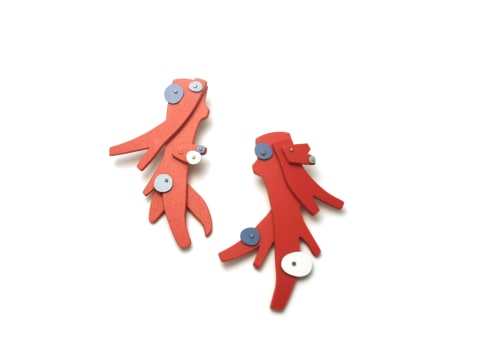
What is black and white and red all over?
It is a riddle, and child’s play, but this time it is not a newspaper.
Paper-thin porcelain, vibrant Formica chips and elemental forms make
up this body of work. I had the pleasure of teaching Foundation
Studies at Nova Scotia College of Art and Design this year and had the
joy of re-discovering the basic principles of visual communication
alongside my students. We mixed colored film together with multiple
slide projectors to create pure white light. We took gorgeous tubes
of primary gouaches and mixed to create deep black. Black and white.
This intrigues me. Light and its shadow are inexorably linked. White
and black are all the vibrant colors of the spectrum, expanded and
contracted. I dreamed of a pure white exhibition, but shadow and then
a pop of red-orange crept in.
The pure white is “Keraflex” a paper-thin porcelain material, made by
a German industrial manufacturer and recently introduced to artists.
In its “green” state it can be easily cut, scored, folded and fused.
When fired it becomes gorgeous translucent porcelain that traps light
in its layers. I was studying folk art, making paper models and pop-up
books with my students and this quietly drifted over into my studio
practice. I spent a year not thinking of jewelry, but experimenting
with this porcelain paper to learn its strengths, possibilities and
most importantly to transcend its 2-D nature and pop it into 3-D.
When I began to make my porcelain forms into jewelry, black became a
natural partner. Black is the shadow found beneath the fold of a white
rose, and it is also the patinaed setting that will join porcelain to
the human form. Red and then all the other colors from Goethe’s color
wheel proceeded to make an appearance. The colored laminate chips
spilled over from previous works; their contrast in color and texture
was too dazzling to be refused.
Without much ado, the jewelry is simple, wearable, but very carefully
articulated to make it appear so. Clearly influenced by the first
modernist sculptors and architects such as Brancusi, Calder, Gropius
as well as cross-cultural folk traditions of paper folding, these
jewels interact clearly and boldly with the human form. This is the
unique opportunity that jewelers have and these elemental forms are
carefully considered to do just that.
R.H. 2010